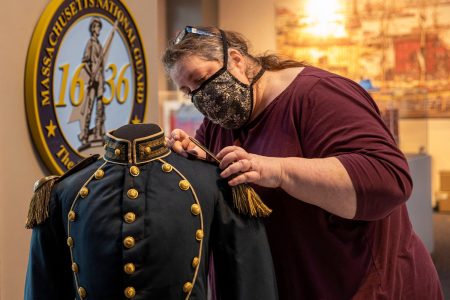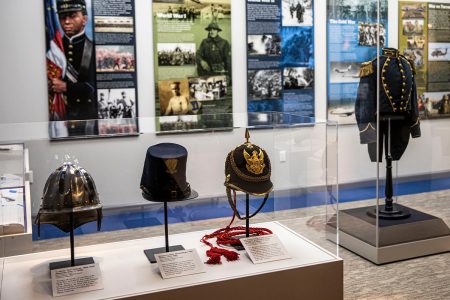 SALEM, Mass. — Dec. 13, 1636, marks the date the General Court of the Massachusetts Bay Colony organized the local militia companies into three regiments—signifying the birth of the National Guard. At the time, all able-bodied men between the ages of 16 and 60 served, supplying much of their own equipment and provisions. Though organized differently today, service members of the National Guard perpetuate the same lineage and spirit as those who served before them.
SALEM, Mass. — Dec. 13, 1636, marks the date the General Court of the Massachusetts Bay Colony organized the local militia companies into three regiments—signifying the birth of the National Guard. At the time, all able-bodied men between the ages of 16 and 60 served, supplying much of their own equipment and provisions. Though organized differently today, service members of the National Guard perpetuate the same lineage and spirit as those who served before them.
To commemorate the 385th anniversary of the National Guard, a museum exhibit highlighting its history, titled “The Nation’s First: A History of the Massachusetts National Guard,” was unveiled at the National Park Service Regional Visitor Center in Salem, Mass., on December 13, 2021. The exhibit serves as a tribute to the enduring legacy of the Guard and its role in both local and national history.
To exhibit the history of the Citizen Soldiers of Massachusetts to the public, the Massachusetts National Guard partnered with the National Park Service. By using the National Park Service Regional Visitor Center, the exhibit is placed in a historically significant setting—a former armory once known as the Salem Armory. This armory was previously used by the Second Corps of Cadets of the Massachusetts Volunteer Militia, who trace their lineage back to 1786. Reaching even further back, in 1637, the first regimental muster of colonial troops was conducted on the Salem Green, a short walk from the exhibit’s location.
regimental muster of colonial troops was conducted on the Salem Green, a short walk from the exhibit’s location.
“Salem is the birthplace of the Massachusetts National Guard, and the National Guard uses 1636 as the birth of the National Guard in the United States,” said Army Brig. Gen. Leonid Kondratiuk (Ret.), Director of Historical Services, Massachusetts National Guard. The descendants of the first regiments remain active in the Massachusetts National Guard today, making them the oldest U.S. Army units—the 181st Infantry, the 182nd Infantry, 101st Field Artillery, and the 101st Engineer Battalion.
Emily Murphy, a museum curator with the National Parks Service, has been instrumental in creating a cohesive, visual representation of the Massachusetts National Guard’s rich and dynamic history. On working with the Guard, she said that it has been a fantastic learning opportunity for both sides.
“Most of the exhibitions that I have done have been internal, with the National Park Service,” said Murphy. “The fact that this is truly a partnership between the National Park Service and the Massachusetts National Guard… it has been really interesting and a fun challenge. I know I have learned an incredible amount by doing this.”
Creating a museum exhibit is no small endeavor. The planning—which took nearly two years—involved development and coordination full of informational considerations and creative decisions: what to feature, what to leave out, and how to present objects and information. Notably, the exhibit includes eight large display panels featuring graphics, illustrations, photos, and text, as well as an informational video offering deeper context.
Murphy stated, “The enthusiasm, the passion, the professionalism has been infectious, and it has been wonderful.”
Though occupying a small portion of the large space of the former armory, visitors can view photos and literature on the Guard’s first muster, along with its participation in major conflicts such as the Civil War, World Wars I and II, the Cold War, the War on Terror, and domestic emergency responses. Also featured are objects and regalia from the militia’s storied past.
“The exhibit features panels that take you through the history of the Massachusetts National Guard from 1636 to present day, as well as objects with real connections to units that continue that history of service,” said David Wilkinson, Visual Information Specialist, Massachusetts National Guard, who assisted with the exhibit. “It’s so important to educate visitors on the service, and most importantly the sacrifice, service members have made and continue to make.”
Within the exhibit experience, there are opportunities for reflection and an atmosphere that appropriately highlights narratives of Soldiers and Airmen, past and present, who have served their communities in the Commonwealth of Massachusetts.
Objects on display that enable this reflective experience include a 1775 powder horn, a decorative haversack light infantry knapsack from the Cambridge Light Infantry, a WWII army service cap, and a shako hat from 1851. At the center of the exhibit is a Sixth Massachusetts Militia Regiment service uniform “coatee,” worn by a member of the Worcester, Mass., militia when they mobilized to Baltimore on April 19, 1861, and were attacked by a mob of protesting civilians.
“I think there’s a great opportunity for self-reflection on the part of the Guard about their history and looking at ways to tell more diverse stories and to think about some of the actions of the Guard in the past. There are some lessons to be learned from the history of the Guard and how they were used,” said Murphy.
The precise role of the National Guard has been a recurring question throughout its long history. By featuring the Massachusetts National Guard’s involvement in its various capacities—within the Commonwealth and abroad, historically and contemporarily—using objects, text, video, and other museum assets, the exhibit may serve to empower and inspire visitors while helping them understand the role of the National Guard.
“As visitors walk through the exhibit space, they will get a visual sense of the role the Massachusetts National Guard has played throughout the history of the Commonwealth and the Nation. They will understand that the Soldiers and Airmen they see driving in a convoy down a highway during a state emergency have the same lineage and the same sense of service Soldiers had centuries ago,” said Wilkinson.
Story and photos by Sgt. 1st Class Kenneth Tucceri, 65th Theatre Public Affairs Support Element (TPASE)